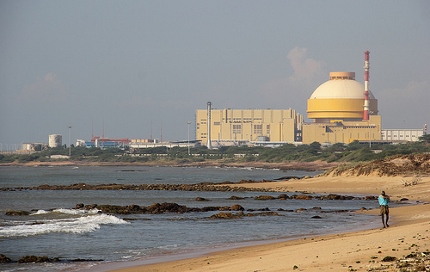As India aims to quadruple nuclear power generation by 2020, activists call for stringent safety measures and liability rules while stressing that the lessons from Fukushima must be heeded

When will India learn the Fukushima lesson and press the pause button on its nuclear energy programme? That’s the question activists are asking as the world observed the third anniversary of one of the world’s worst nuclear accidents triggered by a 9.0 magnitude earthquake that hit Japan in March 2011.
The Fukushima disaster, effects of which will continue to be felt for decades to come, seems to have had little impact on the debate in India, where power is an emotive issue with millions forced to live with prolonged outages or even no electricity at all. Despite global fears on the issue of nuclear energy, India aims to generate 20,000 megawatts of nuclear power by 2020. There are currently 20 nuclear power plants in operation in India, producing around 5,000 megawatts of electricity
“The Indian government has embarked on a criminal and mindless programme to expand nuclear energy. Unfortunately, the current government has never seen the nuclear liability act as an instrument to protect public interest,” lawyer Prashant Bhushan told journalists at a recent meeting organised by Greenpeace.
“From the inception of the bill, it has always been seen by the government as a way of capping the liability of private players to as low a level as possible in order to ‘be attractive’ as a market,” he added.
Bhushan, a supporter of the People’s Movement against Nuclear Energy which opposed the construction of the Kudankulam Nuclear Power Plant in India’s southern state of Tamil Nadu, has been fighting a legal battle for the clarity and absolute liability for the upcoming third and fourth units at the plant. The case is now in the Supreme Court.
Expressing concern over the ongoing India-Russia negotiations over the Kudankulam nuclear reactors, India’s anti-nuclear campaigners have alleged that the government is bypassing supplier liability provisions.
“What we are hearing is that the government is talking about easing the norms and holding the suppliers liable only for the first five years during the licensing period. This doesn’t make sense,” said Hozefa Merchant, Greenpeace campaigner. “If you look at the history of nuclear disasters, Chernobyl happened nine years after the plant was set up, while Fukushima tragedy happened 40 years later. So if a disaster takes place after the five-year period, who will be held responsible?”
thethirdpole.net attempted to contact the Nuclear Power Corporation of India (NPCIL) and the Atomic Energy Regulatory Board (AERB) for a response but to no avail. Department of Energy (DAE) spokesperson S.K. Malhotra told thethirdpole.net, “The negotiations are still going on.” He refused to comment further.
The first 1,000 megawatt unit of the Kudankulam Nuclear Power Plant became operational in October 2013, while work on the second unit has begun. However, work at Units 3 and 4 has been delayed due to Russia’s concerns over the operator’s responsibility as per India’s nuclear liability law. The Civil Liability for Nuclear Damage Act was enacted in 2010 to provide civil liability for nuclear damage and prompt compensation for victims in the event of a nuclear disaster. However, activists point out that the law needs to be made more stringent.
“The cost of the Fukushima nuclear disaster is estimated to be Rs.15 lakh crore (about US$244 billion). But India’s nuclear liability act caps the financial responsibility on the operator to a mere Rs.1,500 crore (about US$244 million) and this is not even one thousandth of the cost that Japan will be spending on clean up and compensation,” said Bhushan.
Satyajit Chavan has seen the horrors of Fukushima first hand and has been fighting to save the pristine areas of Ratnagiri in western India’s Maharashtra state from the planned Jaitapur nuclear power plant.
“Fukushima is permanently damaged. I met a farmer who had to kill all his 50 cows to contain radioactive contamination,” the activist said after a visit to Fukushima’s ground zero. He fears that the proposed Jaitapur plant will have an irreversible impact on the Ratnagiri region.
“Ratnagiri is a very fertile belt where people are dependent on Alphonso mango, cashew farming and fisheries. The livelihoods of both the farmers and the fishermen are at stake”, he added.
The proposed 9,900 megawatt Jaitapur nuclear power project to be set up by NPCIL will be spread across 938 hectares at Madban village of Ratnagiri district in Maharashtra. The plant will comprise six European Pressurised Reactors, or light water reactors imported from French company Areva.
The project has met stiff opposition from local villagers and anti-nuclear activists due to environment and safety concerns. On April 11, 2011, a protesting villager was allegedly shot at by the police when the protests turned violent.
Protests broke out again in March this year. “On the third anniversary of Fukushima, nearly 500 villagers put up a protest to remind the government to rethink its decision of setting up the nuclear plant and to take people’s views into account. Their lives will be most directly affected by the project,” said Chavan.
The Maharashtra government has moved swiftly to complete the land acquisition despite stiff resistance. As of August 30 last year, only 141 of total 2,336 project-affected villagers had accepted compensation cheques. Six months later, in February, nearly 1,600 villagers gave in. But Chavan reiterated that locals are still opposed to the project. “People accepted cheques because their land was acquired by the government. It doesn’t mean they have agreed to the nuclear power plant. We will carry on with the fight,” he said.
As the Japanese government continues to grapple with the fallout of Fukushima, which led to 1,600 deaths and over 160,000 people being displaced, it is to be seen if the Indian government will pay heed to the voices of the local people and put robust safety measures in place.